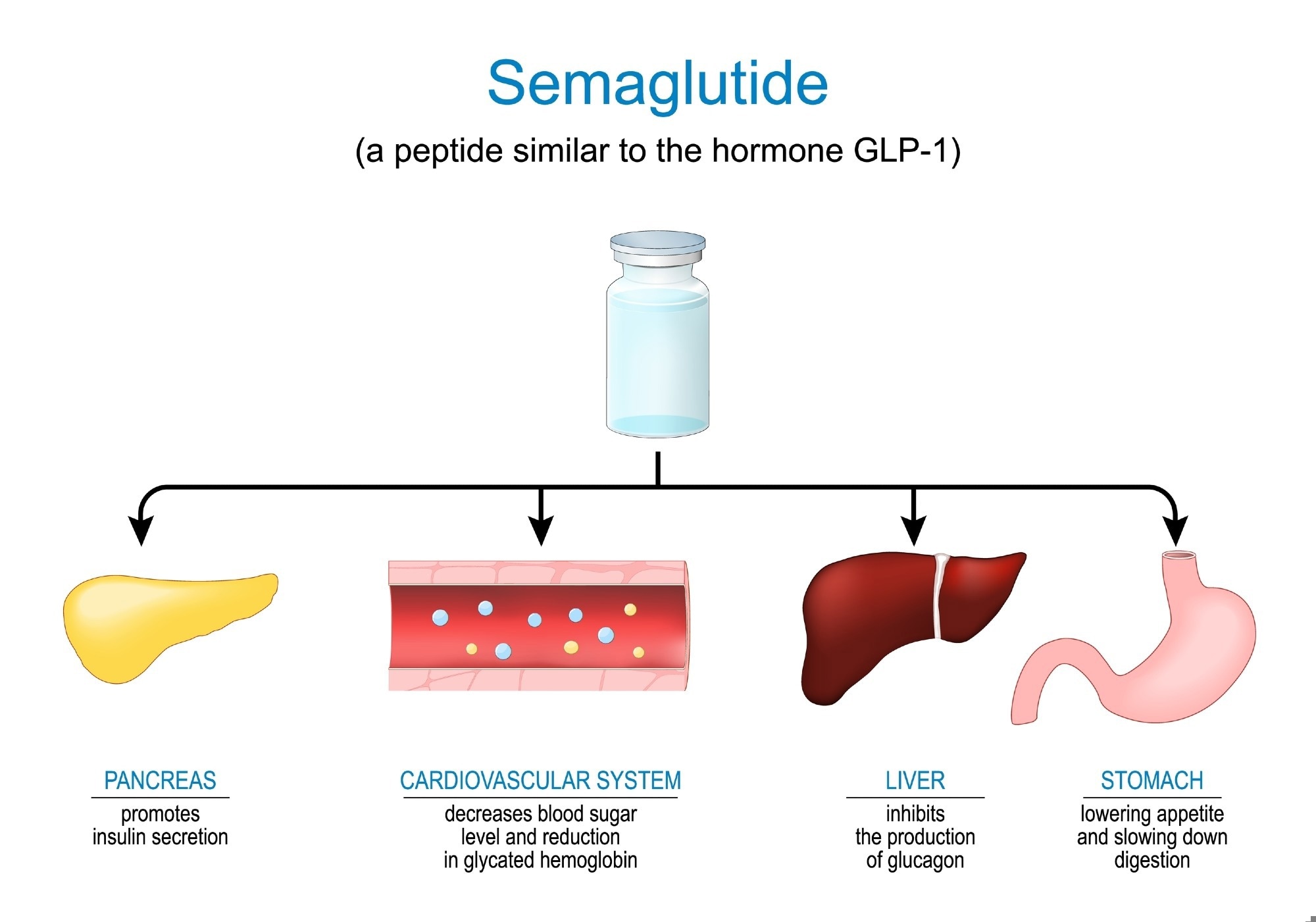Understanding semaglutide
How semaglutide aids weight loss
Beyond weight loss
Safety and side effects
Semaglutide and weight management
References
Further reading
Semaglutide, commonly known as Ozempic, is a glucagon-like peptide 1 (GLP-1) agonist utilized for glycemic control in type 2 diabetes (T2D) and obesity management. It is an effective weight loss drug, functioning by mimicking a satiety hormone, reducing appetite, and slowing gastric emptying. This prolonged action helps users feel fuller for longer, controlling weight loss when combined with diet and exercise.

Image Credit: MillaF/Shutterstock.com
Understanding semaglutide
Semaglutide is a medication that has gained significant attention for its efficacy in managing weight loss.1 As a GLP-1 agonist, it mimics the physiological effects of natural GLP-1 released in the body.1
In response to glucose intake, the PPG neurons in the central nervous system (CNS) and the L-cells in the gut produce and secrete GLP-1, an inhibitory gastrointestinal hormone.1
When released, GLP-1 activates its receptor, GLP-1R, in the pancreatic islet β cells, provoking a myriad of metabolic changes characterized by insulin secretion and appetite suppression.1
This insulin secretion causes an overall decrease in blood sugar levels, reduces the production of glucagon, which prevents the release of glucose storage from the liver, and induces a satiety response that elevates insulin sensitivity and causes weight loss.1
This medication works to stimulate insulin secretion in a glucose-dependent manner, therefore decreasing the risk of hypoglycemia.1 In addition, they have positive long-term effects on β cell survival, proliferation, and neogenesis.1
It’s been studied that semaglutide primarily mimics the effects of GLP-1 released from the gut, not the brain.2 This is because most brain GLP-1 receptors are beyond the reach of these systemically administered drugs.2 Despite the limited direct action on brain GLP-1 receptors, semaglutide remains highly effective in reducing food intake and body weight.2
It seems to achieve this by activating a network of neurons throughout the CNS, with many of these neurons being secondary targets that do not directly express GLP-1 receptors.2 In 2024, the approved commercial versions of semaglutide are Ozempic3-4, Rybelsus3,5, and Wegovy injection3,6, developed by Novo Nordisk.
Who Should Take Weight Loss Injections, and Who Shouldn’t?
How semaglutide aids weight loss
Semaglutide significantly impacts CNS processes, including satiety, thermogenesis, blood pressure regulation, neurogenesis, and inflammation reduction.7
Due to its longer half-life, semaglutide has prolonged CNS effects, regulating appetite and metabolic processes.7 It decreases food intake, slows gastric emptying, and promotes the secretion of hormones like leptin and peptide YY, which are crucial for satiety.7
In pancreatic β-cells, GLP-1R activation by semaglutide enhances glucose catabolism and insulin secretion via the mTOR-dependent HIF-1α pathway, facilitating glycolysis and insulin release.7
Under normal conditions, this release can occur quickly, peaking around 10 minutes after the initial glucose stimulus.7 It is then followed by a prolonged release from 90–95% of insulin granules that can persist for up to 60 minutes.7
This is in part caused by its counteracting effect on DPP-4, a GLP-1 inhibitor, prolonging the GLP-1R signal and maintaining insulin secretion.7 Semaglutide also activates the AMPK pathway, promoting GLUT4 translocation to the plasma membrane, which increases glucose uptake and homeostasis.7

Image Credit: Designua/Shutterstock.com
Beyond weight loss
Semaglutide has gained significant attention for its positive effects in managing type 2 diabetes (T2D), obesity, and cardiovascular risk reduction.1
T2D is characterized by elevated blood sugar levels caused by either insufficient production of insulin or improper insulin function, also referred to as insulin resistance.8 Over time, elevated blood sugar levels can result in a range of health complications affecting multiple organ systems, including the heart, kidneys, feet, and retina.8
In patients with T2D, semaglutide is effective in lowering blood sugar levels and promoting weight loss.9 Clinical trials have demonstrated that it can reduce HbA1c levels when added to metformin, and patients experience an average reduction of over 15% in body weight.9
Additionally, it has been shown to reduce the risk of developing T2D by 60%, regardless of whether patients have prediabetes or normal blood sugar levels.10 This reduction in diabetes risk is crucial since T2D is associated with an increased risk of heart disease and other cardiometabolic complications.10
Semaglutide has demonstrated significant cardiovascular benefits, particularly in reducing the risk of major adverse cardiovascular events, such as heart attacks and strokes.11 The SELECT trial showed a 20% reduction in the risk of these events in adults with obesity and cardiovascular disease but no prior history of diabetes.11
The cardiovascular benefits of semaglutide are attributed to several mechanisms beyond weight loss.11 These include reductions in blood pressure, blood lipids, and inflammation, as well as direct effects on the heart muscle and blood vessels.7,11
GLP-1 agonists help modulate chronic inflammation associated with obesity by suppressing proinflammatory cytokines such as TNF-α, IL-6, and IL-1β, improving endothelial function.7
Safety and side effects
Semaglutide, while beneficial for managing type 2 diabetes and weight loss, is not without side effects.12 Commonly, patients may experience gastrointestinal disturbances such as nausea, vomiting, diarrhea, and constipation.12
Less frequently, there can be more serious effects, including pancreatitis or allergic reactions.12 Due to these potential side effects, medical supervision is crucial when initiating and maintaining treatment with semaglutide.

Image Credit: Anna Piszko/Shutterstock.com
Healthcare providers can help manage and mitigate side effects, ensuring the benefits outweigh the risks for each individual, taking into account the medical history of the patient and the potential drug interactions.12-13
Semaglutide and weight management
Incorporating lifestyle factors such as diet and exercise is crucial when using semaglutide for weight loss.14-15 While semaglutide can be an effective treatment, it is not a substitute for healthy eating and regular physical activity.14-15
Long-term changes in diet and activity are essential for maintaining weight loss and preventing weight regain after stopping the medication.14-15 It is important to note that obesity is a chronic disease, and discontinuing semaglutide can lead to weight regain due to a decrease in lean mass and basal metabolic rate (BMR).14-15
Therefore, a holistic approach that includes lifestyle modifications and medical supervision is necessary for sustainable weight management.
References
- Marzook, A., Tomas, A., & Jones, B. (2021). The interplay of Glucagon-Like peptide-1 receptor trafficking and signalling in pancreatic beta cells. Frontiers in Endocrinology, 12. https://doi.org/10.3389/fendo.2021.678055
- Trapp, S., & Brierley, D. I. (2021). Brain GLP‐1 and the regulation of food intake: GLP‐1 action in the brain and its implications for GLP‐1 receptor agonists in obesity treatment. British Journal of Pharmacology, 179(4), 557–570. https://doi.org/10.1111/bph.15638
- Center for Drug Evaluation and Research (n.d.) Medications containing semaglutide, U.S. Food and Drug Administration. [Online] https://www.fda.gov/drugs/postmarket-drug-safety-information-patients-and-providers/medications-containing-semaglutide-marketed-type-2-diabetes-or-weight-loss.
- Ozempic® (semaglutide) injection for Type 2 Diabetes. (n.d.). [Online] https://www.ozempic.com/
- Type 2 Diabetes Medicine | RYBELSUS® (semaglutide) tablets. (n.d.). [Online] https://www.rybelsus.com/
- Weight-Loss Prescription Medication | Wegovy® (semaglutide) Injection 2.4 mg. (n.d.). [Online] https://www.wegovy.com/
- Tamayo-Trujillo, R, et al. (2024). Molecular mechanisms of semaglutide and liraglutide as a therapeutic option for obesity. Frontiers in Nutrition, 11. https://doi.org/10.3389/fnut.2024.1398059
- Type 2 diabetes. (n.d.). Diabetes UK. [Online] https://www.diabetes.org.uk/diabetes-the-basics/types-of-diabetes/type-2
- Chamberlin, S., & Dabbs, W. (2019). Semaglutide (Ozempic) for Type 2 Diabetes Mellitus. AAFP. [Online] https://www.aafp.org/pubs/afp/issues/2019/0715/p116.html
- Pope, A. (2022). “Transformational” semaglutide can cut Type 2 diabetes risk by more than half - News. UAB News. [Online] https://www.uab.edu/news/research/item/13156-transformational-semaglutide-can-cut-type-2-diabetes-risk-by-more-than-half
- Semaglutide lowers cardiovascular risk regardless of blood sugar. (2024). [Online] https://www.utsouthwestern.edu/newsroom/articles/year-2024/june-cardiovascular-risk-blood-sugar.html
- GoodRx - (n.d.). [Online] https://www.goodrx.com/ozempic/semaglutide-side-effects
- Ozempic Drug Interactions Checker (n.d.) Drugs.com. [Online] https://www.drugs.com/drug-interactions/semaglutide,ozempic-index.html
- Taylor. (2024). The Pros and Cons of Semaglutide for Weight Loss - Dr. Taylor. Southwest Family Medical. [Online] https://swfamilymedical.com/pros-cons-semaglutide-for-weight-loss
- Ms, N. S. (2023). Ozempic Rebound: Why Most People Regain Weight After Stopping Semaglutide. Healthline. [Online] https://www.healthline.com/health-news/weight-regain-after-stopping-ozempic
Further Reading
Last Updated: Feb 27, 2025